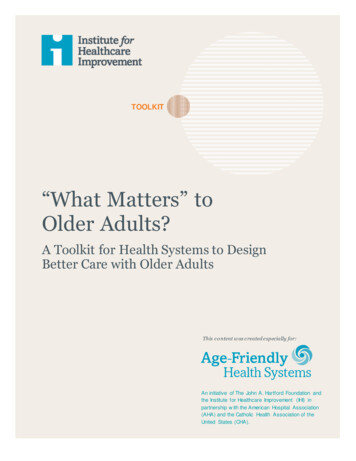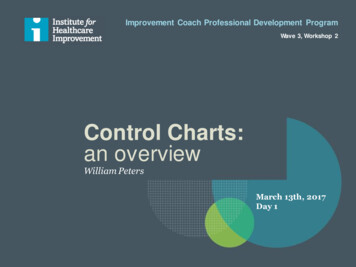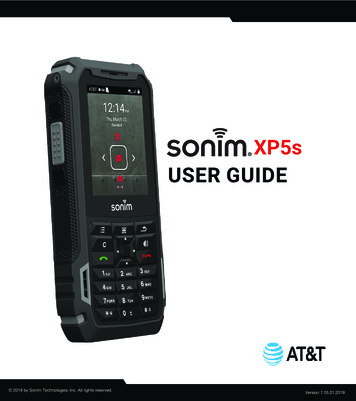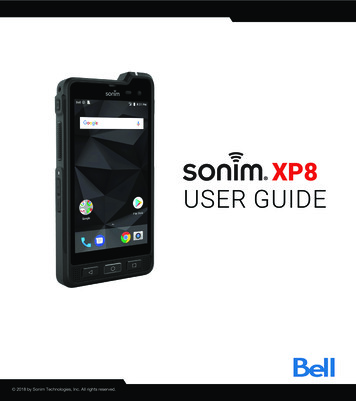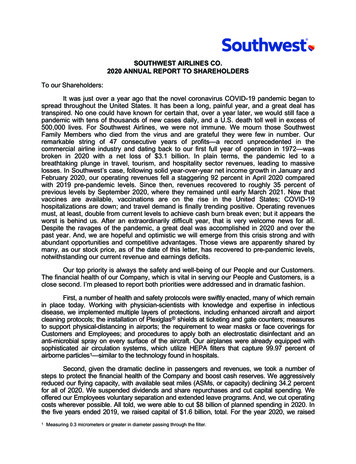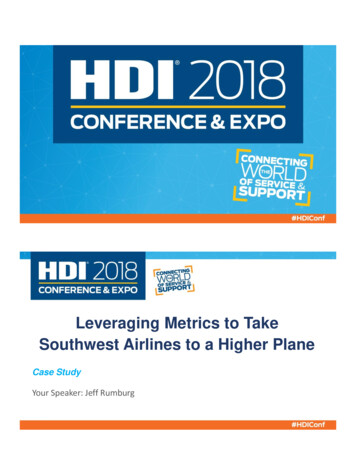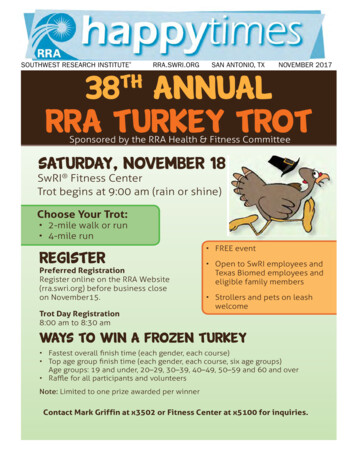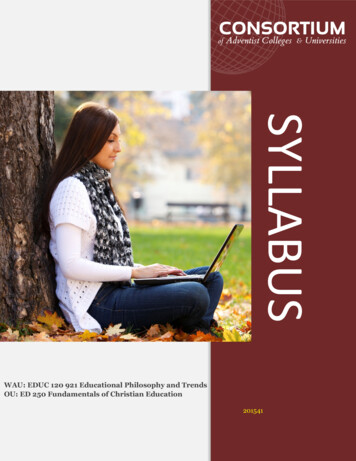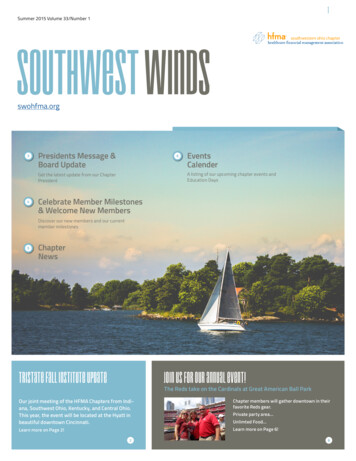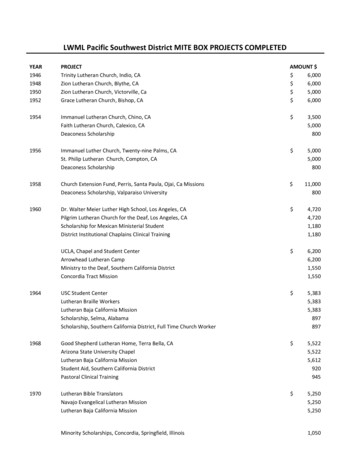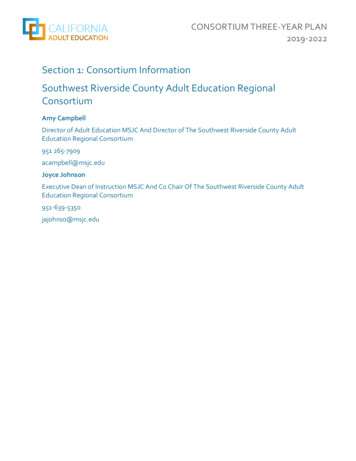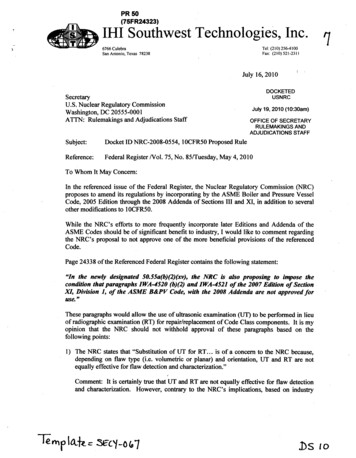
Transcription
PR 50(75FR24323)I&TIHI Southwest Technologies, Inc.6766 CulebraSan Antonio, Texas 78238Tel: (210) 256-4100Fax: (210) 521-2311July 16, 2010DOCKETEDUSNRCSecretaryU.S. Nuclear Regulatory CommissionWashington, DC 20555-0001ATTN: Rulemakings and Adjudications StaffJuly 19, 2010 (10:30am)OFFICE OF SECRETARYRULEMAKINGS ANDADJUDICATIONS STAFFSubject:Docket ID NRC-2008-0554, 1OCFR50 Proposed RuleReference:Federal Register Vol. 75, No. 85/Tuesday, May 4, 2010To Whom It May Concern:In the referenced issue of the Federal Register, the Nuclear Regulatory Commission (NRC)proposes to amend its regulations by incorporating by the ASME Boiler and Pressure VesselCode, 2005 Edition through the 2008 Addenda of Sections III and XI, in addition to severalother modifications to 1OCFR50.While the NRC's efforts to more frequently incorporate later Editions and Addenda of theASME Codes should be of significant benefit to industry, I would like to comment regardingthe NRC's proposal to not approve one of the more beneficial provisions of the referencedCode.Page 24338 of the Referenced Federal Register contains the following statement:"In the newly designated 50.55a(b)(2)(xv), the NRC is also proposing to impose thecondition that paragraphsIWA-4520 (b)(2) and IWA-4521 of the 2007 Edition of SectionXI, Division 1, of the ASME B&PV Code, with the 2008 Addenda are not approvedforuse."These paragraphs would allow the use of ultrasonic examination (UT) to be performed in lieuof radiographic examination (RT) for repair/replacement of Code Class components. It is myopinion that the NRC should not withhold approval of these paragraphs based on thefollowing points:1) The NRC states that "Substitution of UT for RT. is of a concern to the NRC because,depending on flaw type (i.e. volumeiric or planar) and orientation, UT and RT are notequally effective for flaw detection and characterization."Comment: It is certainly true that UT and RT are not equally effective for flaw detectionand characterization. However, contrary to the NRC's implications, based on industryrlaA:zeo/-0I)sq/
experience, UT is typically deemed more effective than RT for flaw detection. UT maynot be as effective as RT for flaw characterization, however for repair and replacementactivities in operating reactors, it would seem logical to use UT examinations inconjunction with ASME Section XI style acceptance criteria (flaw analysis based on size,location, and significance) for operating reactors, than to use Construction Code styleacceptance criteria (based on workmanship standards, which require flaw characterizationand may or may not have significance relative to component integrity). If NRC is trulyinterested in detecting flaws and analyzing those flaws with respect to their impact onoperational safety, the NRC should require UT where practical rather than allow RT forthese repair and replacement activities.2) The NRC states that "RT is effective in detecting volumetric-type flaws (e.g. . ), planartype flaws with large openings (e.g. . ), and those flaws that are oriented in a planeparallel to the X-ray beam. . Ifi contrast, UT is most effective in detecting and sizingplanar-type flaws associated with inservice degradation due to, for example, fatigue orstress corrosion cracking."Comment: While it is agreed that RT is effective in detecting certain types of flaws, itshould be noted that there are few studies that have actually attempted to measure ordemonstrate the effectiveness of RT in a manner comparable to the way the effectivenessof UT has been demonstrated via ASME Section XI, Appendix VIII.The quoted NRC statements imply that UT is not effective for detection or sizing ofvolumetric-type flaws or planar-type flaws with large openings. UT can be very effectivein detecting and sizing volumetric flaws and other fabrication induced defects if thetechniques are applied properly. During the preservice examinations performed in the USin the 1970s and early 1980s, there were many examples of fabrication flaws that weredetected with UT that were not identified by RT. There were also many examples offlaws that were detected with UT which were later correlated with acceptable RT results.Unfortunately, although the occurrence of these examples is well known, specificdocumentation is probably not readily available at this time since most of these examplesoccurred over 25 years ago. Unfortunately, since there was no requirement to correlateacceptable construction RT results with preservice UT results, the number of flaws thatmay have been acceptable based on the RT results but missed with UT is unknown. Itshould also be noted that these preservice UT examinations were performed with UTprocedures that had not be "performance demonstrated" in accordance with current Coderequirements.The quoted statements also imply that UT is better suited for detection of planar flawsthan volumetric flaws. While UT is better than RT for detection of planar flaws, UT isactually better for detection of volumetric flaws than it is for detection of planar flaws. Avery simple example would be a comparison of the anticipated UT response from a midwall side-drilled hole versus the anticipated UT response from a mid-wall planar reflector.Unless the planar reflector was oriented normal to the sound beam, and holding othervariables constant, one would expect a much smaller response from the planar reflector.
3) The NRC addresses the limitations of UT on cast stainless steel components and statesthat ".the ASME Code provisions addressing the inspection of cast stainless steels arestill under development and are, therefore, not yet published for use."Comment: The limitations regarding use of UT in cast stainless steel materials is wellknown and is a valid concern where those materials are used. However, it seems logicalto allow UT to be performed on those materials where it is known to be more effectivethan RT instead of continuing to require RT on those materials. Also, it should be notedthat "inspection" requirements (what, when, and how to inspect) for cast stainless steelmaterials are currently addressed in the ASME Code. It is the UT "qualification"requirements (procedure demonstration) for cast stainless steel materials that are stillunder development.4) The NRC states "Finally, UT requires more surface scanning area that RT to performexaminations."Comment: While it is true that UT requires more access and may also require more weldsurface preparation that RT, the other peripheral benefits of UT (or disadvantages of usingRT) should not be ignored, some of which are:a. Use of RT requires isolation areas and work area restrictions that are not requiredwhen performing UT.b. Time required to perform UT is typically much less than needed to perform RT.c. The performance of RT includes some amount of inherent radiation exposure (andsome risk of accidental over-exposure) that do not occur with UTd. RT sources are known to be a potential national security risk and restrictions ontheir storage and use have increased considerably in recent years. The use of UTrather than RT will minimize the risk to national security associated withtransportation and use of these radiographic "Quantities of Concern".5) The NRC states "To ensure that a UT technique would be capable of detecting typicalconstruction flaws, the NRC would require a licensee to demonstrate, throughperformance-based ASME B&PV Code, Section XI, Appendix VIII-like requirements, itscapability of identifying the construction flaws which are easily detected by RT."Comment:Appendix VIII was designed to test the capabilities of UT systems(techniques, equipment, and personnel) under blind conditions. The effectiveness of RTsystems (techniques, equipment, and personnel) have not undergone this type of rigorousblind testing qualification program, so although the RT techniques may be capable of"easily detecting construction flaws", no consideration is given to the potential negativeeffects that personnel may have on the overall effectiveness of an RT system. Thepremise that UT systems would need to undergo an Appendix VIII stylequalification/demonstration program for construction flaws prior to use seems illogicalwhen RT examination systems have not undergone a similar rigorous qualificationprogram to date. It also seems illogical that RT systems would continue to be mandated
for use in repair and replacement activities when the RT systems have not been subjectedto a similar performance demonstration program.6) The NRC states their concern that ". using the second leg of the ultrasound metal path(V-path) to achieve two direction scanning from only one side of the weld may not beadequate in detecting construction flaws."Comment: This concern is valid, especially for austenitic stainless steels and nickelalloys, and may be a basis for limiting the use of UT in these materials when only one sideof a weld is accessible. The ability to detect certain types of smooth flaws (e.g. lack offusion) that are oriented parallel to the sound beam on the second leg of the V-path may belimited when using manual conventional UT techniques. More advanced UT techniques(e.g. automated phased array) offer improved ability to detect such flaws but there is not asignificant amount of industry experience to validate that improvement, nor is the currentAppendix VIII implementation program (The Performance Demonstration Initiative)capable of currently administering such a qualification. However, even considering theselimitations, it would seem logical to allow UT to be performed on materials andcomponents where UT is known to be as effective, or more so, than RT.Considering the above, instead of blanket disapproval, the NRC should consider approvingthe substitution of UT for RT with specific conditions or limitations, such as:1) UT may not be used in lieu of RT for examination of cast stainless steel or austeniticstainless steels and nickel alloys where only single-sided access is available,2) When UT is used in lieu of RT, the acceptance standards of ASME Section XI IWA3000 shall be used in lieu of the construction code acceptance standards, and3) Encoded or automated UT shall be used to create a permanent record which wouldallow multiple analysis reviews as well as document the results for comparison withfuture examinations.This approach would provide benefits to licensees in many cases, but would restrict the use ofUT in situations where it is known to be less effective than RT.Sincerely,Gr y L aglederPresidentIHI Southwest Technologies
.Rulemaking CommentsFrom:Sent:To:Subject:Attachments:Grady Lagleder [Glagleder@ihiswt.com]Friday, July 16, 2010 12:40 PMRulemaking CommentsDocket ID NRC-2008-0554, 10CFR50 Proposed RuleNRC Letter 7-16-2010. pdfPlease see the attached letter containing comments regarding the subject Docket ID. The Proposed Rule was publishedin the Federal Register, Vol. 75, No. 85, on Tuesday May 4, 2010.Thank you,Grady LaglederIHI Southwest Technologies210-256-41031
Received: from mail .nrc.gov (148.184.176.41) by OWMS01.nrc.gov(148.184.100.43) with Microsoft SMTP Server id 8.1.393.1; Fri, 16 Jul 201012:39:46 -0400X-Ironport-ID: maUlX-SBRS: 4.5X-MID: 18380462X-fn: NRC Letter 7-16-2010.pdfX-ironPort-Anti-Spam-Filtered: Port-AV: E Sophos;i "4.55,215,1278302400";d "pdf'?scan'208,217";a "1 8380462"Received: from serverl04.appnver.com ([207.97.242.49]) by maill.nrc.gov withESMTP; 16 Jul 2010 12:39:45 -0400Received: by serverl04.appriver.com (CommuniGate Pro PIPE 5.3.7) with PIPE id258353878; Fri, 16 Jul 2010 12:39:55 -0400Received: from [216.253.136.2] (HELO IHI-SERVER-l.ihiswt.com) byserverl04.appriver.com (CommuniGate Pro SMTP 5.3.7) with ESMTP id 258353845for Rulemaking.Comments@nrc.gov; Fri, 16 Jul 2010 12:39:46 -0400X-MimeOLE: Produced By Microsoft Exchange V6.5Content-Class: um:content-classes:messageMIME-Version: 1.0Content-Type: multipart/mixed;boundary"---- NextPart 001 01CB2505.775BC71E"Subject: Docket ID NRC-2008-0554, 10CFR50 Proposed RuleDate: Fri, 16 Jul 2010 11:39:31 -0500Message-ID: I.ihiswt.com X-MS-Has-Attach: yesX-MS-TNEF-Correlator:Thread-Topic: Docket ID NRC-2008-0554, IOCFR50 Proposed RuleThread-Index: AcslBXcxiLS 8BluQpeyzvoKYAtC3Q From: Grady Lagleder Glagleder@ihiswt.com To: Rulemaking.Comments@nrc.gov X-Policy: GLOBAL - ihiswt.comX-Primary: glagleder@ihiswt.comX-Note: This Email was scanned by AppRiver SecureTideX-ALLOW: @ihiswt.com ALLOWEDX-Note: VCH-CT/SI:0-1 201 /SG:1 7/16/2010 12:38:45 PMX-Virus-Scan: V-XOMOX-Note: Spam Tests Failed:X-Country-Path: UNITED STATES- UNITED STATESX-Note-Sending-IP: 216.253.136.2X-Note-Reverse-DNS:X-Note-WHTLIST: Glagleder@ihiswt.comX-Note: User Rule Hits:X-Note: Global Rule Hits: G200 G201 G202 G203 G207 G208 G219 G307X-Note: Encrypt Rule Hits:X-Note: Mail Class: ALLOWEDSENDERReturn-Path: glagleder@ihiswt.com
serverl04.appriver.com (CommuniGate Pro SMTP 5.3.7) with ESMTP id 258353845 for Rulemaking.Comments@nrc.gov;
